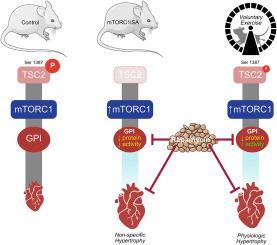Journal of Molecular and Cellular Cardiology ( IF 4.9 ) Pub Date : 2021-06-01 , DOI: 10.1016/j.yjmcc.2021.05.016 Giovanni E Davogustto 1 , Rebecca L Salazar 1 , Hernan G Vasquez 1 , Anja Karlstaedt 1 , William P Dillon 1 , Patrick H Guthrie 1 , Joseph R Martin 1 , Heidi Vitrac 2 , Gina De La Guardia 1 , Deborah Vela 3 , Aleix Ribas-Latre 4 , Corrine Baumgartner 4 , Kristin Eckel-Mahan 4 , Heinrich Taegtmeyer 1

|
Rationale
The nutrient sensing mechanistic target of rapamycin complex 1 (mTORC1) and its primary inhibitor, tuberin (TSC2), are cues for the development of cardiac hypertrophy. The phenotype of mTORC1 induced hypertrophy is unknown.
Objective
To examine the impact of sustained mTORC1 activation on metabolism, function, and structure of the adult heart.
Methods and results
We developed a mouse model of inducible, cardiac-specific sustained mTORC1 activation (mTORC1iSA) through deletion of Tsc2. Prior to hypertrophy, rates of glucose uptake and oxidation, as well as protein and enzymatic activity of glucose 6-phosphate isomerase (GPI) were decreased, while intracellular levels of glucose 6-phosphate (G6P) were increased. Subsequently, hypertrophy developed. Transcript levels of the fetal gene program and pathways of exercise-induced hypertrophy increased, while hypertrophy did not progress to heart failure. We therefore examined the hearts of wild-type mice subjected to voluntary physical activity and observed early changes in GPI, followed by hypertrophy. Rapamycin prevented these changes in both models.
Conclusion
Activation of mTORC1 in the adult heart triggers the development of a non-specific form of hypertrophy which is preceded by changes in cardiac glucose metabolism.
中文翻译:

代谢重塑先于 mTORC1 介导的心脏肥大
基本原理
雷帕霉素复合物 1 (mTORC1) 及其主要抑制剂块茎素 (TSC2) 的营养感应机制靶点是心脏肥大发展的线索。mTORC1 诱导的肥大的表型是未知的。
客观的
检查持续 mTORC1 激活对成人心脏代谢、功能和结构的影响。
方法和结果
我们通过删除Tsc2开发了一种可诱导的、心脏特异性持续 mTORC1 激活 (mTORC1 iSA )的小鼠模型。在肥大之前,葡萄糖摄取和氧化的速率,以及葡萄糖 6-磷酸异构酶 (GPI) 的蛋白质和酶活性降低,而葡萄糖 6-磷酸 (G6P) 的细胞内水平升高。随后,出现肥大。胎儿基因程序的转录水平和运动诱导肥大的途径增加,而肥大并未发展为心力衰竭。因此,我们检查了进行自愿体育活动的野生型小鼠的心脏,并观察到 GPI 的早期变化,然后是肥大。雷帕霉素在两种模型中都阻止了这些变化。
结论
成人心脏中 mTORC1 的激活会引发非特异性肥大形式的发展,其之前是心脏葡萄糖代谢的变化。











































 京公网安备 11010802027423号
京公网安备 11010802027423号